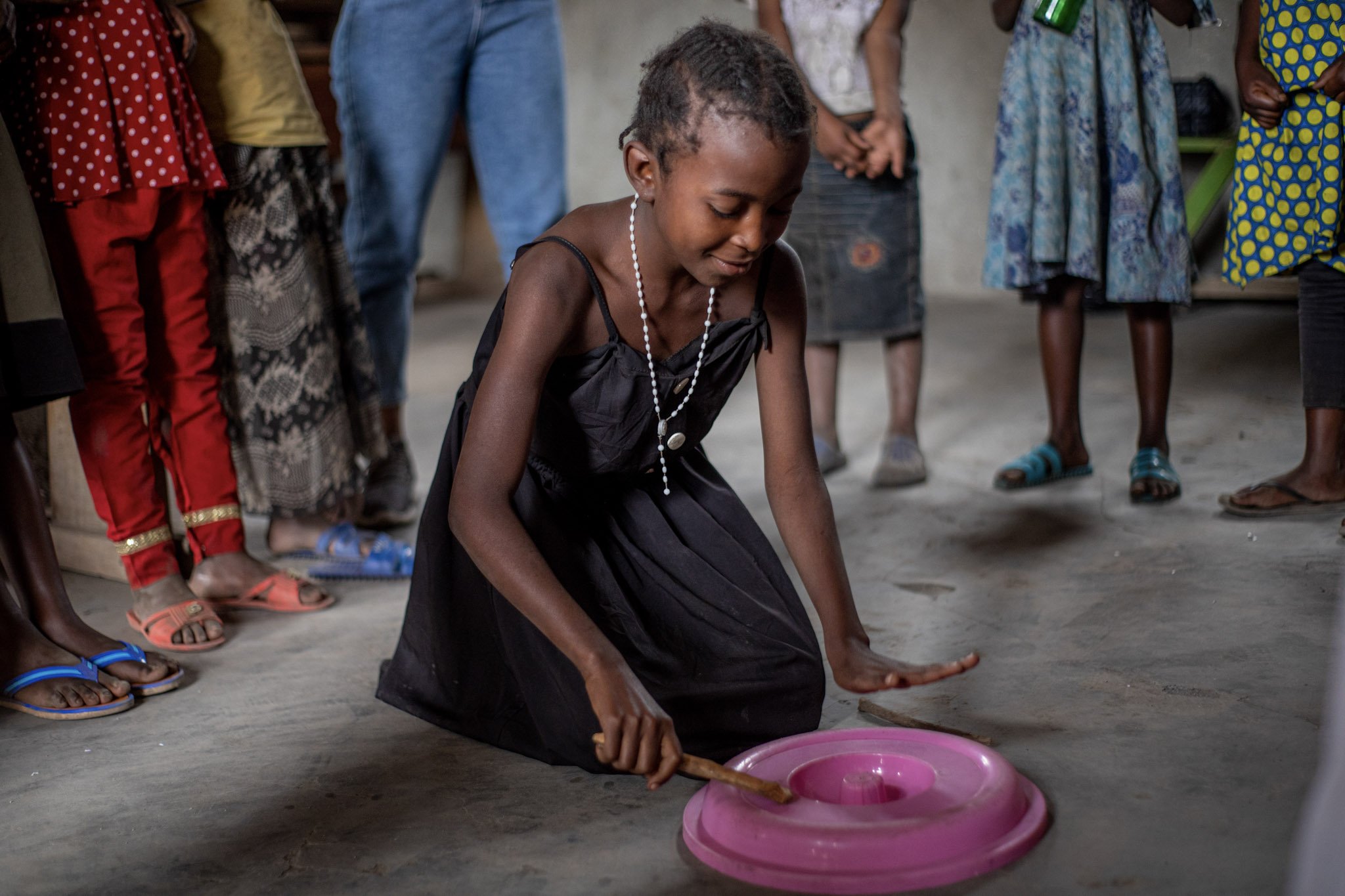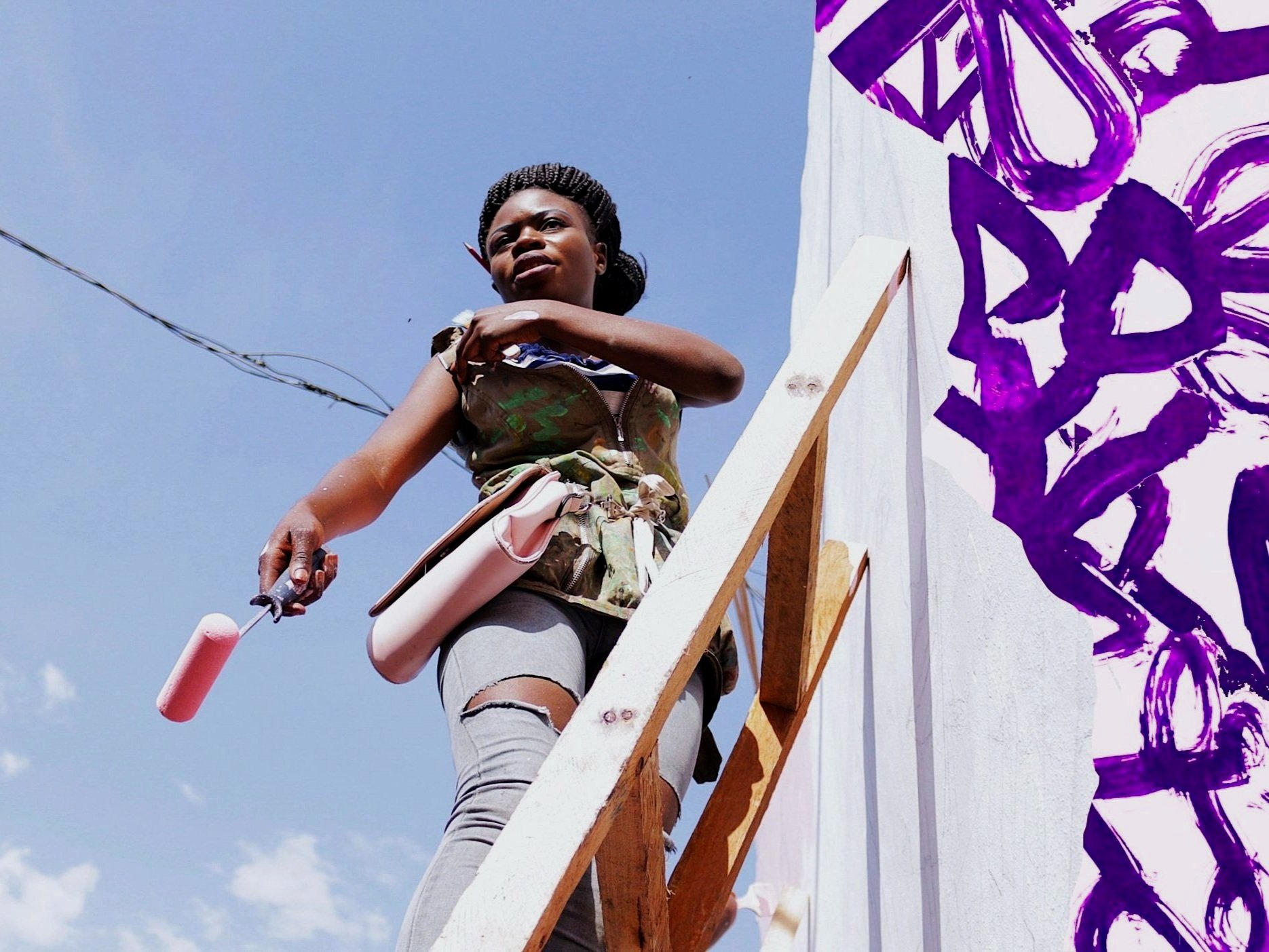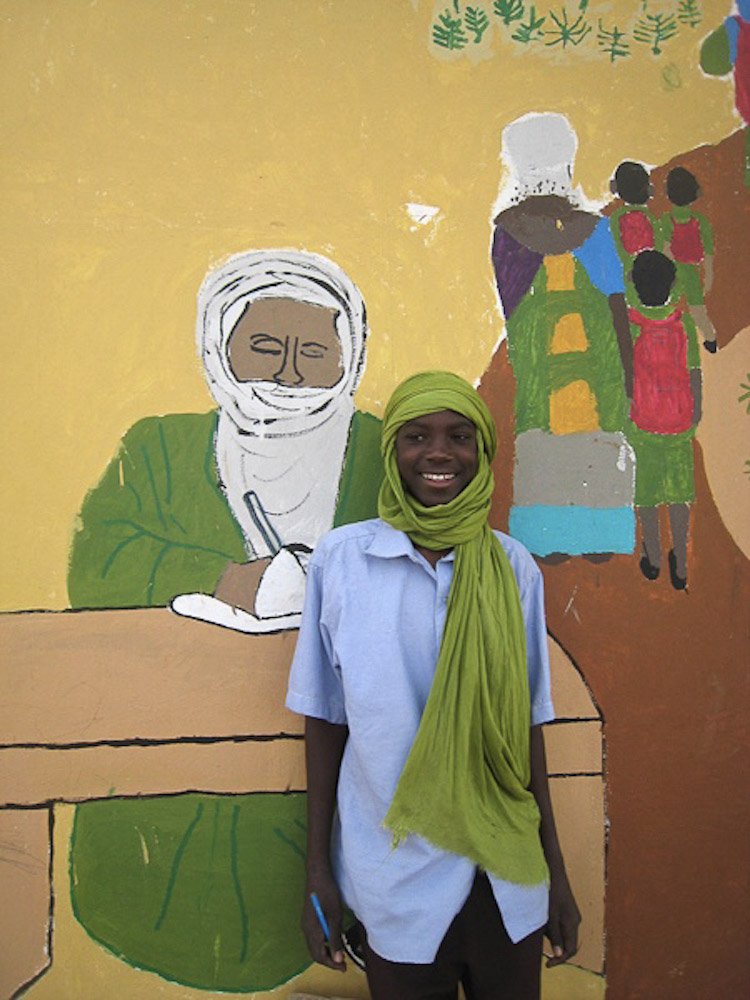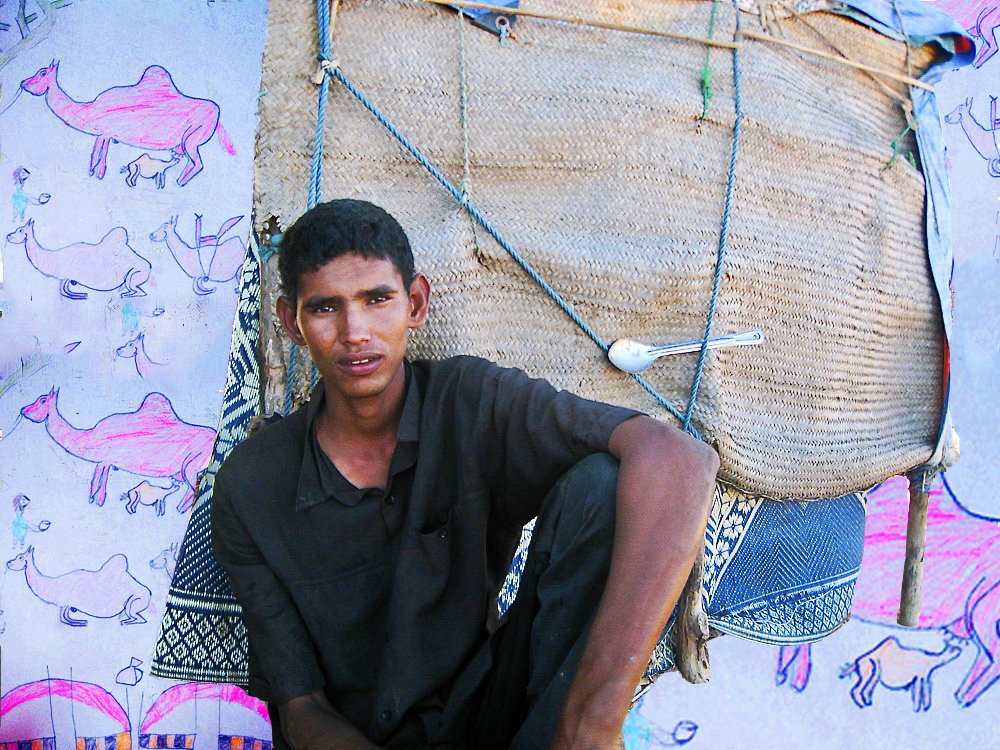
The impact of our work is helping transform lives
With the support of our programs, girls and young women are better able to protect themselves and heal from gender-based violence. Through positive relationships and connections forged, they develop confidence, leadership visibility, and a voice in their communities. Youth experience a healing process, and joy to envision their future.
The effects of these impacts are boundless.
To date, we have implemented ten projects in refugee camps and post-war communities in Sub-Saharan Africa.
552 youth have expressed and demonstrated more confidence after participating in our arts-based programs.
Our 60 public murals and posters have reached more than 412,000 residents in those communities.
Our Impact Areas
Our Impact on
Mental Health and Wellbeing
Perpetual stress and trauma
Life-altering traumatic and stressful events are commonly experienced roughly 8 times a year in communities with endemic poverty and conflict - compared to the USA norm of experiencing the same type of events only 4 times over a lifetime; in other words, twice as many traumatic experiences in one year than a US citizen experiences in an entire lifetime.
The mental healthcare gap for people living in low and middle-income countries is significant.
Of the more than 1 billion people globally living with a mental health disorder- 80% live in low and middle income countries and 75% do not have access to any treatment.
Mental health impacts individual lives, relationships, and communities.
Perpetual stress and trauma disrupt a person’s ability to function day to day, relate to others meaningfully, imagine better futures, and problem-solve both domestic and community concerns. The impact of reducing individuals’ abilities impacts entire communities’ abilities to solve their as well as some of the world’s most pressing global challenges.
Arts-based mental health interventions help people cope with trauma, build resilience, and move forward in their lives.
For low-resource communities, art-based approaches to mental health are positively life-altering.
Colors of Connection’s programs do the important work of putting individuals on a path to a better quality of life and a sense of well-being through trauma-informed art programs.
35% or 1 in 3 women and girls globally will experience physical or sexual violence in their lifetimes WHO, 2021
In conflict settings such as eastern Congo, this percentage can escalate to 70 %
Girls and young women in low and middle income countries are 1.5X to 2X more likely than boys to be diagnosed with clinical depression during adolescence.
The mental health and well-being of girls and women are in extreme peril.
How we made an impact
60 Murals and posters created by 552 youth, reaching 412,000 community members in conflict-affected communities.
“Awakened” is how one community member described the youth in a Malian refugee camp in West Africa after they completed the Colors of Connection program. After several months of making art, and engaging in self and collective expression.
“My daughters don't understand what I tell them to do or give them advice. Espe even had suicidal and rebellious thoughts. She thought she was not loved and often said she was going to kill herself. Since they started attending the Musichana Hamuka Program, they understand me, they are motivated, they have found interest and hope in life.”
-Mother of two girl participants, Girl Awakening Program, Goma, DRC
“I feel good in my skin when I am doing art”
—Participant, Tunaweza Portraits Project, Goma DRC
“I feel as if something new has been born in me”
—Participant, Tunaweza Portraits Project, Goma DRC
Did you know?
Making art is a helpful way for people suffering from trauma and PTSD to express their emotions and move toward healing.
Dive deeper into our projects regarding Mental health and Wellbeing
Girl Awakening
Mitigating trauma, and supporting girls in an urban, densely populated neighborhood in Goma, DRC.
Tunaweza Portraits
Provided therapeutic arts-based activities, social support and leadership development to girls in Goma, DRC.
Goudoubo Refugee Camp
Supported the development and emotional well-being of out-of-school refugee youth in Burkina Faso.
Our Impact on
Gender Equality
Girls are on the frontlines of organizing for change their communities, as well as one of the most marginalized groups facing constant violence and abuse.
Where CC works, girls are regularly excluded from basic societal protections and benefits that are taken for granted in many places. They are denied healthcare and education, and experience sexual and gender-based violence from an early age.
One in three women and girls worldwide will experience physical or sexual violence in their lifetime and one in five women report being sexually abused as a child.
Research confirms that supporting girls not only transforms their lives for the better, but has a ripple effect positively impacting the health and development of their communities and countries.
We at Colors of Connection know that this is true because we have seen it happen.
We engage with some of the most marginalized girls in conflict affected and fragile communities providing them with a safe female-only space where they can meet regularly, learn, build solidarity, and develop strategies for change. They learn essential life skills and develop voice and expression and are provided with a school scholarship.
How we made an impact
Through participation in the program girls shared that they gained improved standing in their families and communities, and were seen as being more valuable, thus reducing their experience of GBV and discrimination; gained greater confidence and belief in their own internal capabilities; and reported having much improved peer support networks. Community members reported having an improved perception of girls and their ability to contribute to society.
429 girls reached
110 girls enrolled in school
191,000 community members reached with through 33 murals and posters on gender quality
“These murals and messages, they help make sure that girls are listened to when they don’t have sufficient voice within society. They make people think twice about what they think they know about girls, and what they are capable of doing”
—Community leader, Tunaweza Portraits Project, Goma, DRC
"My daughters were afraid of life and people. They were very shy and they couldn't express themselves. They were very closed in on themselves. But since they started attending the Musichana Hamuka program, they have become more outgoing than before. I have seen my daughters get closer and confide in me—something that had not happened before. When they come back, they share with me what they have learned and we have time to discuss it . . . I also think that it's the games (icebreakers and arts activities) that they play at the space that have helped them a lot to grow and be open."
-Mother of two girl participants, Girl Awakening Program, Goma, DRC
Did you know?
Creativity develops a range of positive assets.
Our arts-based activities support girls Gender Equality
Navigating gender identity and social, psychological and physical spaces shaped by gender norms.
Developing and strengthening coping mechanisms and trauma healing processes, including the ability to imagine a different future.
Create new relationships and deepen group solidarity, reduce girls’ feeling of isolation in experiences of GBV.
Dive deeper into our projects regarding Gender Equality
Girl Awakening
Providing a safe space where girls in Goma, DRC can learn, build solidarity, and strategize for social change.
Tunaweza Portraits
Promoted female leadership and enabled community dialogue around gender roles. Goma, DRC.
Courage in Congo
Provided a safe space for girls to gain the skill sets to overcome challenges in their daily lives in Goma, DRC.
Our Impact on
Social cohesion and peacebuilding
Art is a powerful source of healing and rebuilding when a community has been deeply disrupted.
Violence and conflict are on the rise worldwide. Climate change, political conflict, deepening wealth disparity and worsening poverty are adding to the problem. As the intensity and scale of conflict grows, society is torn apart: homes and buildings destroyed, family members and friends lost, empty time and space replace the parts of life school and jobs occupied, and a disrupted daily life stripped of its natural rhythm. Disrupted too are the everyday expressions of the creative self and community, such as music, the comfort of traditional food, and often the parts of life that bring people together and connect them.
We know as human beings that art nourishes and inspires us. Research shows us that making art helps communities and individuals tell—and listen—to each other’s stories. Art fosters empathy and helps us understand other perspectives. History tells us art plays an instrumental role in every social movement and push for progress; it is instrumental in inspiring us and igniting hope.
Because of this, Colors of Connection engages with art as a vehicle for healing and change. During our programs, girls, marginalized youth, and community leaders tap into ways to creatively express themselves and engage with each other through painting, drawing, movement, music, and dialogue. Together, they paint large murals in their community transforming part of their world into their own powerful vision of the future.
Did you know?
Social cohesion and peacebuilding are positively impacted by arts processes?
They have been found to be effective in helping communities and individuals tell and listen to each other’s stories. This allows a more complex and nuanced narrative, and understandings of identity.
Thus individuals and communities are better able to imagine how future conflicts will be engaged in constructively.
How we made an impact
60 Murals and posters created by 552 youth, reaching 412,000 community members in conflict-affected communities.
Issa was a 17 year old boy who participated in our project in Goudoubo Refugee Camp, Burkina Faso. He and his family were driven from their home in northern Mali during the Tuareg Rebellion in 2012, an ongoing crisis destabilizing Mali and displacing more than 1.2 million people.
Ethnic tensions helped fuel this conflict, and they were part of life in the refugee camp where Issa fled. Issa came with other out-of-school youth from the camp to our bi-weekly sessions. For most of these youth, our program was the first place they interacted with others outside their ethnic groups. By the end of the project, Issa explained how this changed him.
“Before [the project] I was afraid of the other ethnicities, to be together with them. But attending the class changed me, now I understand them and can work together with them. And they understand me better too.”
—Issa, Goudoubo Project Participant
“If the youth, who are the strength of the society, understand this message of peaceful cohabitation, all will be well for the future.”
-Ati Wallet Ibrahim, Resident of Goudoubo Refugee Camp
Dive deeper into our projects regarding social cohesion and peacebuilding
Mentao Refugee Camp
Enabled youth from disparate ethnic groups to overcome harmful stereotypes and work together in Burkina Faso.
Goudoubo Refugee Camp
Enabled youth from disparate ethnic groups to overcome harmful stereotypes and work together in Burkina Faso.
Visions of Hope
Engaged with youth and community in Liberia to transform war-torn landscape through murals in Liberia
























